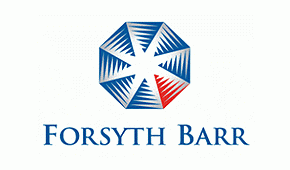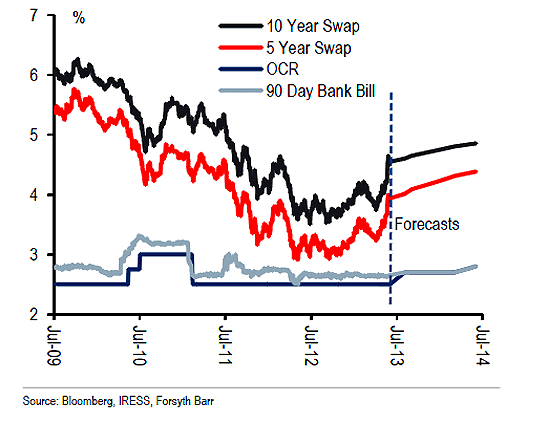
Content supplied by Forsyth Barr:
The following is a summary of the key events impacting fixed income markets over the past week.
New Zealand just following along
Despite being a short week in the US due to 4 July celebrations, it turned out to be a busy one, with an interesting trading session on Monday US time, to come.
Given that everything now seems to revolve around the Fed and its proposed ‘tapering/exit’ from its money-printing program, the Bank of England (BoE) and the European Central Bank (ECB) broke with tradition and offered guidance on their respective interest rate outlook.
Central bank rates going nowhere
The ECB said “The Governing Council expects the key ECB interest rates to remain at present or lower levels for an extended period of time... ...What the Governing Council did today (last week) was to inject a downward bias in interest rates for the foreseeable future. Our exit is very distant.”
It was a similar story in the UK with the BoE pouring cold water on market expectations that the central bank would lift rates. The BoE said the current market pricing for future interest rate rises was “not warranted by the recent developments in the domestic economy”.
The distinction between central bank rates and swap rates is an important distinction to make.
New Zealand interest rates (New Zealand Government bond yields and swap rates) appear to be at the mercy of the offshore moves with most of the market now pricing in the impact of ‘tapering’. The US 10 year bond yield is nearly at a two year high and the NZGB 10 year bond is +130bp higher since its record low in May.
Credit markets
Credit spreads were mixed over the week, tighter or wider by a couple of basis points around the globe. In New Zealand, the yield on the ANZ Investment Grade Bond Index rose +9bp to 4.65% (+74bp higher than its low of 3.91% in May 2013).
There is another round of US earnings releases this week, which may provide a guide to the health/performance of the US corporate sector.
What is looking on the up, is the US labour market. The much anticipated US non-farm payrolls data released last Friday night once again beat forecasts of 160,000 with 195,000 jobs created in June with positive revisions of 20k more jobs added in May.
The unemployment rate (a key indicator for the Fed) remained at 7.6% as the labour force expanded.
Wholesale versus cash rates
There has been significant commentary surrounding the recent rise in wholesale interest rates. There has also been significant commentary surrounding the ‘lower for longer’ theme with regard to central bank rates.
What is the difference? And are interest rates going up or staying lower for longer?
Given the recent sharp rises in the wholesale rates, we thought it prudent to touch on the differences and the impact any move in interest rates has on investors and borrowers alike.
Central bank rates such as New Zealand’s Official Cash Rate (OCR) provides the RBNZ with a means of influencing the level of economic activity and inflation.
What it does not do anymore is influence the cost to a bank when it raises medium to long-term funds, both domestically or offshore. That rate is called the swap rate and this is the key rate for bond investors and borrowers.
If swap rates rise, then so will fixed rate mortgage rates and bond rates as we have witnessed, particularly over the last two weeks. Why are swap rates rising?
Two of the main reasons are a lift in hedging activity by the New Zealand business sector and households and secondly, a more positive economic outlook for New Zealand and in particular, the US. Many New Zealand households have moved from floating rate mortgages to fixed rate mortgages over the last year.
Just over half (51%) of mortgages are now fixed compared to 37%1 in April 2012. This increased demand has contributed to rising swap rates as borrowers look to lock in record low mortgage rates.
Although mortgage rates have just begun to move higher (at the 3yr, 4yr, 5yr maturity) on the back of rising swap rates, the sub 5% ‘specials’ that many of the banks had been offering have been removed.
Overall, if swap rates continue to rise, it will be highly likely that higher mortgage rates will follow which in turn see greater demand for fixed rate mortgages.
Increasing demand equals higher swap rates as banks hedge the fixed rate demand in the swap market. Higher swap rates has a negative and a positive impact for fixed income investors in that existing bond portfolios will be negatively impacted by rising swap rates, however if there were to be any new corporate bond issuance (a big if) it will be priced off a higher benchmark rate (a higher swap rate) providing investors with a higher coupon rate.
It should be noted that the use of the OCR primarily impacts the shorter end of the curve whereas the offshore markets dictate what happens at the long-end of the curve.
The current Bloomberg forecasts (illustrated below) suggest that swap rates are expected to edge higher with no (or very little) movement in the cash rate/OCR until the end of 2014 according to the RBNZ.

1 RBNZ Statistics
Corporate/Credit News
ANZ Banking Group Limited (ANZ) announced an offer of A$750m (with the ability to raise more or less) Additional Tier 1 capital. The expected margin range is 3.4-3.6% above the Australian 180-day bank bill rate with the coupons fully franked.
The Debt Management Office (DMO) sold NZ$300m of Inflation-Indexed Government bonds which received NZ$446m worth of bids. The bonds were sold at an average yield of 2.2455%.
Genesis Energy (GPLFA) announced the results of its election process. Existing Capital Bond holders elected to retain NZ$198.8m of the existing NZ$275m Capital Bonds while seeking an additional NZ$10.7m. Genesis will allocate NZ$1.1m of new bonds to bring the number of GPLFA’s on issue to the desired NZ$200m. The coupon rate will be set on 10 July at 2.15% over the prevailing five-year swap rate. If set today, the coupon would be ~6.30%.
The NZX released its June monthly operating metrics illustrating once again the decline in the listed debt market. The total number of listed debt instruments fell -11.7% versus a year ago with the number of trades falling -22.2% over the year.
SKYCITY Entertainment Group Limited (SKC) finally signed the full Project and Licensing Agreement with the New Zealand Government to design, build, own and operate the New Zealand International Convention Centre (NZICC). SKC will invest NZ$402m in return for a package of regulatory concessions.
Westpac (WBC) launched a three-year floating rate note. WBC is seeking to raise between NZ$200m - $500m from the unlisted issue which has an indicative margin of 75bp - 80bp over the 90 day Bank Bill rate.
What’s coming up this week?
The release of the Fed policy meeting minutes and a speech by the Fed Chairman, Ben Bernanke, will be a feature of the market events this week. The demand for over US$60bn in US Treasuries this week will be of interest given the rise in yields of late.
Another weary eye will also be closely watching the Eurozone where Greece hopes it will convince the International Monetary Fund, European Union and the ECB to provide it with €8.1bn in aid.
To date, Greece has failed to deliver on its public sector reform targets and received an extension from the troika a few months back.
----------------------------------------------------
Disclosures and Disclaimers:
Disclosure: The comments in this publication are for general information purposes only. This publication is not intended to constitute investment advice under the Securities Markets Act 1988. If you wish to receive specific investment advice, please contact your Investment Advisor. Forsyth Barr Limited and its related companies (and their respective officers, agents and employees) may own or have an interest in securities or other products referred to in this publication, and may be directors or officers of, or provide investment banking services to, the issuer of those securities or products, and may receive fees for acting in any such capacity in relation to that issuer. Further, they may buy or sell securities as principal or agent, and as such may undertake transactions that are not consistent with any recommendations contained in this publication. Forsyth Barr Limited and its related companies (and their respective officers, agents and employees) confirms no inducement has been accepted from the researched/recommended entity, whether pecuniary or otherwise, in connection with making any recommendation contained in this publication or on our website.
Analyst Disclosure Statement: In preparing this publication the analyst(s) may or may not have a threshold interest in the securities mentioned in this publication. A threshold interest is defined as being a holder of more than $50,000 or 1% of the securities on issue, whichever is the lesser. In preparing this publication non-financial assistance may have been provided by the entity being researched. A disclosure statement is available on request and is free of charge.
Disclaimer: This publication has been prepared in good faith based on information obtained from sources believed to be reliable and accurate. However, that information has not been independently verified or investigated by Forsyth Barr Limited. Accordingly, Forsyth Barr Limited: (a) does not make any representation or warranty (express or implied) that the information is accurate, complete or current; and (b) excludes and disclaims (to the maximum extent permitted by law) any liability for any loss which may be incurred by any person as a result of that information being inaccurate or incomplete in any way or for any reason. The information, analyses and recommendations contained in this publication are confidential to the intended recipients and are statements of opinion only. They have been prepared for general information purposes and whilst every care has been taken in their preparation, no warranty or representation is given (express or implied) as to their accuracy or completeness. Nothing in this publication should be construed as a solicitation to buy or sell any security or other product, or to engage in or refrain from doing so or engaging in any other transaction. This publication should not be used as a substitute for specific advice. This publication is intended to provide general securities advice only, and has been prepared without taking account of your objectives, financial situation or needs, and therefore prior to acting on any information, analysis or recommendation contained in this publication, you should seek advice from your usual Investment Advisor. Forsyth Barr Limited and its related companies (and their respective officers, agents and employees) will not be liable for any loss whatsoever suffered by any person relying upon any such information, analysis or recommendation. This publication is not intended to be distributed or made available to any person in any jurisdiction where doing so would constitute a breach of any applicable laws or regulations.
1 Comments
Although mortgage rates have just begun to move higher (at the 3yr, 4yr, 5yr maturity) on the back of rising swap rates, the sub 5% ‘specials’ that many of the banks had been offering have been removed.
Is ANZ still using subsidised funds from RBNZ OCR penalised depositors, even though they are the primary risk takers under OBR if insolvency visits this institution, or any one of them for that matter?
We welcome your comments below. If you are not already registered, please register to comment
Remember we welcome robust, respectful and insightful debate. We don't welcome abusive or defamatory comments and will de-register those repeatedly making such comments. Our current comment policy is here.